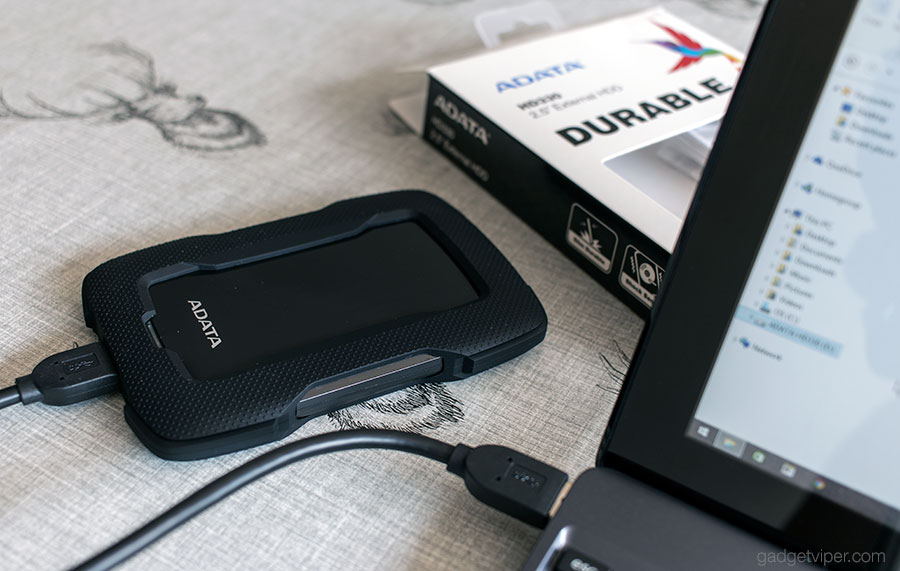ADATA HD330 External Hard Drive
An affordable external storage solution from ADATA with sensor technology designed to pause drive activity when a shock is detected.
The durable HD330 comes with a 3-year warranty and is available in three colours and four capacities ranging from 1TB up to 5TB’s.
Highlights and Features
- USB-A 3.1 Connection
- 1TB, 2TB, 4TB and 5TB capacities
- Shock resistant sensor technology
- Available in Black, Red, and Blue
- AES 256-bit encryption
- Slim Design at only 16mm (1/2TB)
- Works with HDDtoGO software
Pros and Cons
Where to Buy
ADATA HD330 Full Review
The HD330 comes inside a tidy retail box along with USB 3.1 cable and quick start guide. The cable looks and feels robust, but at only 12 inches, I’d have liked a little more length…
The guide makes mention of an impressive 3-year warranty and points you online to the optional HDDtoGo software.
The drive will function straight out of the box without installing additional files, but for those planning to use it on a Windows PC, it’s definitely worth checking out.
The software makes it easy to backup specific folders, synchronise your data and has a number of useful security features including a 256-bit AES encryption. I won’t bore you with all the details, but for those interested, he’s a link to the user manual.
The Design and Build Quality
The ADATA HD330 comes in four different capacities and two physical sizes, depending on if you choose the 1/2TB or the 4/5TB drives. Both are impressively compact for an HDD and could definitely be considered as pocket size.
| Dimensions (L x W x H) | 1/2TB : 132.7 x 88.9 x 16.2mm (5.2 x 3.5 x 0.6 inches) 4/5TB : 132.7 x 89.9 x 23.4mm (4.9 x 3.2 x 0.9 inches) |
| Weight | 1/2TB : 189.8g /6.69oz 4/5TB : 315.6g /11.13oz |
The drive has a textured silicone protective case with dense rubber cushions on the corners to absorb impacts. The front has a glossy surface that I’m not a fan of. I always prefer a matt non-shiny finish on my portable devices given the choice. Greasy fingerprints and unwanted reflections are unappealing and easily avoided.
There’s a thin LED status indicator below the ADATA logo that will glow blue when on, flash blue when transferring data, flash red when a shock is detected and remain red in the event of an error.
ADATA HD330 Features
The HD330 has a USB 3.1 output and is backwards compatible with USB 2.0 ports. It will work with all versions of Windows going back as far as XP. It’s also compatible with Mac OS X 10.6 or later and Linux Kernel 2.6 or later.
The drive is going to work from the moment it’s connected to a laptop, PC, or Mac. If, however, you’re eager to use the HDDtoGo software features, you’ll need to be running Windows.
If not, there are plenty of other third-party software solutions that work well with different operating systems.
ADATA’s proprietary shock sensors
If you’ve suffered from errors caused by bad sectors, it’s possible the hard drive was knocked while saving data. The HD330 has a clever solution to prevent this from happening. With the use of internal shock sensors, the drive will pause activity during excessive motion then automatically resume once it’s safe to do so. This could be very useful if you work while travelling.
HD330 Speed / Performance
While the HD330 is not going to compare well against SSD, it does an ok job when tested against other HDD drives in its price bracket. I’ve currently got a 1TB secondary hard drive in my PC called a Seagate Barracuda. Using CrystalDiskMark software I was able to compare the two, here are the results:
Verdict
The ADATA HD330 is a compact, durable, and cost-effective external storage solution. Its slim design, rugged case, and built-in shock sensors make it ideal for use while travelling. The read/write speeds are above average and while I definitely wouldn’t game from this or any other HDD for that matter, it’s certainly good enough for backing up files. For those looking for a reliable and rugged external storage solution on a budget, the HD330 is well worth considering.





























Thanks for the review, I was looking for a rugged external SSD, this seems ideal- cheers.